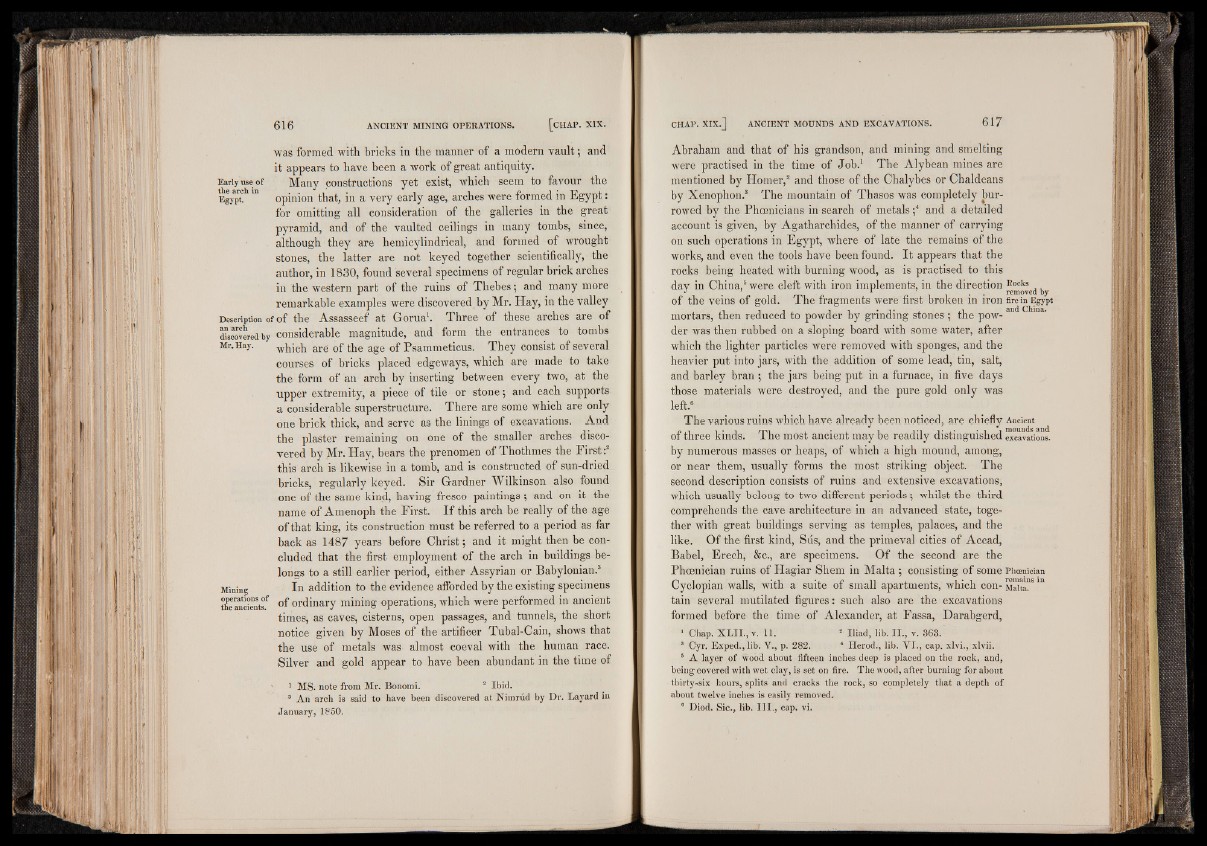
was formed with bricks in the manner of a modern vault; and
it appears to have been a work of great antiquity.
Early use of Many constructions yet exist, which seem to favour the
Egypt. ' opinion that, in a very early age, arches were formed in Egypt:
for omitting all consideration of the galleries in the great
pyramid, and of the vaulted ceilings in many tombs, since,
although they are hemicylindrical, and formed of wrought
stones, the latter are not keyed together scientifically, the
author, in 1830, found several specimens of regular brick arches
in the western part of the ruins of Thebes; and many more
remarkable examples were discovered by Mr. Hay, in the valley
Description of of the Assasseef at Gorua1. Three of these arches are of
discovered by considerable magnitude, and form the entrances to tombs
Mr. Hay. which are of the age of Psammeticus. They consist of several
courses of bricks placed edgeways, which are made to take
the form of an arch by inserting between every two, at the
upper extremity, a piece of tile or stone; and each supports
a considerable superstructure. There are some which are only
one brick thick, and serve as the linings of excavations. And
the plaster remaining on one of the smaller arches discovered
by Mr. Hay, bears the prenomen of Thothmes the First:2
this arch is likewise in a tomb, and is constructed of sun-dried
bricks, regularly keyed. Sir Gardner Wilkinson also found
one of the same kind, having fresco paintings; and on it the
name of Amenoph the First. I f this arch be really of the age
of that king, its construction must be referred to a period as far
back as 1487 years before Christ; and it might then be concluded
that the first employment of the arch in buildings belongs
to a still earlier period, either Assyrian or Babylonian.3
Mining In addition to the evidence afforded by the existing specimens
the andents^ °f ordinary mining operations, which were performed in ancient
times, as caves, cisterns, open passages, and tunnels, the short
notice given by Moses of the artificer Tubal-Cain, shows that
the use of metals was almost coeval with the human race.
Silver and gold appear to have been abundant in the time of
1 MS. note from Mr. Bonorai. 2 Ibid.
3 An arch is said to have been discovered at Nimrud by Dr. Layard in
January, 1850.
Abraham and that of his grandson, and mining and smelting
were practised in the time of Job.1 The Alybean mines are
mentioned by Homer,2 and those of the Chalybes or Chaldeans
by Xenophon.3 The mountain of Thasos was completely burrowed
by the Phoenicians in search of metals ;4 and a detailed
account is given, by Agatharchides, of the manner of carrying
on such operations in Egypt, where of late the remains of the
works, and even the tools have been found. It appears that the
rocks being heated with burning wood, as is practised to this
day in China,5 were cleft with iron implements, in the direction Eocks ,, J 7 1 removed by
of the veins of gold. The fragments were first broken in iron firein Egypt
mortars, then reduced to powder by grinding stones ; the powder
was then rubbed on a sloping board with some water, after
which the lighter particles were removed with sponges, and the
heavier put into jars, with the addition of some lead, tin, salt,
and barley bran ; the jars being put in a furnace, in five days
those materials were destroyed, and the pure gold only was
left.6
The various ruins which have already been noticed, are chiefly Ancient
of three kinds. The most ancient may be readily distinguished excavations,
by numerous masses or heaps, of which a high mound, among,
or near them, usually forms the most striking object. The
second description consists of ruins and extensive excavations,
which usually belong to two different periods ; whilst the third
comprehends the cave architecture in an advanced state, together
with great buildings serving as temples, palaces, and the
like. Of the first kind, Sus, and the primeval cities of Accad,
Babel, Erech, &c., are specimens. Of the second are the
Phoenician ruins of Hagiar Shem in Malta; consisting of some Phoenician
Cyclopian walls, with a suite of small apartments, which con- Mai™8 m
tain several mutilated figures: such also are the excavations
formed before the time of Alexander, at Fassa, Darabgerd,
1 Chap. X L II., v. 11. 2 Iliad, lib. I I ., v. 363.
3 Cyr. Exped., lib. V., p. 282. 4 Herod., lib. Y I., cap. xlvi., xlvii.
5 A layer of wood about fifteen inches deep is placed on the rock, and,
being covered with wet clay, is set on fire. The wood, after burning for about
thirty-six hours, splits and cracks the rock, so completely tiiat a depth of